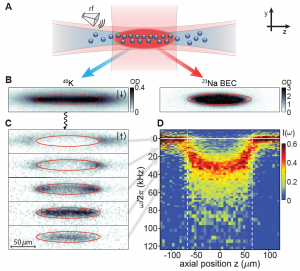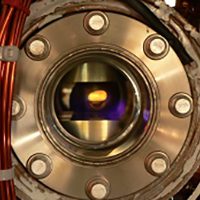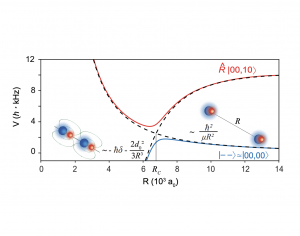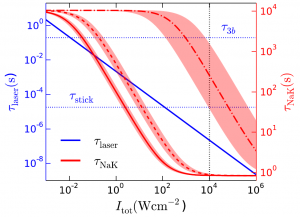- Dissipationless flow in a Bose-Fermi mixture (4/16/2023)
Zoe Z. Yan, Yiqi Ni, Alexander Chuang, Pavel E. Dolgirev, Kushal Seetharam, Eugene Demler, Carsten Robens, Martin Zwierlein
Interacting mixtures of bosons and fermions are ubiquitous in nature. They form the backbone of the standard model of physics, provide a framework for understanding quantum materials such as unconventional superconductors and two-dimensional electronic systems, and are of technological importance in 3He/4He dilution refrigerators. Bose-Fermi mixtures are predicted to exhibit an intricate phase diagram featuring coexisting liquids, supersolids, composite fermions, coupled superfluids, and quantum phase transitions in between. However, their coupled thermodynamics and collective behavior challenge our understanding, in particular for strong boson-fermion interactions. Clean realizations of fully controllable systems are scarce. Ultracold atomic gases offer an ideal platform to experimentally investigate Bose-Fermi mixtures, as the species concentration and interaction strengths can be freely tuned. Here, we study the collective oscillations of a spin-polarized Fermi gas immersed in a Bose-Einstein condensate (BEC) as a function of the boson-fermion interaction strength and temperature. Remarkably, for strong interspecies interactions the fermionic collective excitations evolve to perfectly mimic the bosonic superfluid collective modes, and fermion flow becomes dissipationless. With increasing number of thermal excitations in the Bose gas, the fermions’ dynamics exhibit a crossover from the collisionless to the hydrodynamic regime, reminiscent of the emergence of hydrodynamics in two-dimensional electron fluids. Our findings open the door towards understanding non-equilibrium dynamics of strongly interacting Bose-Fermi mixtures.
- Bose polarons near quantum criticality (4/10/2020)
Zoe Z. Yan, Yiqi Ni, Carsten Robens, Martin W. Zwierlein
Science, 368, 190-194 (2020)

The emergence of quasiparticles in strongly interacting matter represents one of the cornerstones of modern physics. However, when different phases of matter compete near a quantum critical point, the very existence of quasiparticles comes under question. Here we create Bose polarons near quantum criticality by immersing atomic impurities in a Bose-Einstein condensate (BEC) with near-resonant interactions. Using locally-resolved radiofrequency spectroscopy, we probe the energy, spectral width, and short-range correlations of the impurities as a function of temperature. Far below the superfluid critical temperature, the impurities form well-defined quasiparticles. However, their inverse lifetime, given by their spectral width, is observed to increase linearly with temperature, a hallmark of quantum critical behavior. Close to the BEC critical temperature, the spectral width exceeds the binding energy of the impurities, signaling a breakdown of the quasiparticle picture near quantum criticality.
- Resonant dipolar collisions of ultracold molecules induced by microwave dressing (3/5/2020)
Zoe Z. Yan, Jee Woo Park, Yiqi Ni, Huanqian Loh, Sebastian Will, Tijs Karman, Martin Zwierlein
Phys. Rev. Lett. 125, 063401 (2020)
10.1103/PhysRevLett.125.063401
We demonstrate microwave dressing on ultracold, fermionic 23Na40K ground-state molecules and observe resonant dipolar collisions with cross sections exceeding three times the s-wave unitarity limit. The origin of these collisions is the resonant alignment of the approaching molecules’ dipoles along the intermolecular axis, which leads to strong attraction. We explain our observations with a conceptually simple two-state picture based on the Condon approximation. Furthermore, we perform coupled-channels calculations that agree well with the experimentally observed collision rates. While collisions are observed here as laser-induced loss, microwave dressing on chemically stable molecules trapped in box potentials may enable the creation of strongly interacting dipolar gases of molecules.
- Photo-induced two-body loss of ultracold molecules (5/16/2019)
Arthur Christianen, Martin W. Zwierlein, Gerrit C. Groenenboom, Tijs Karman
Phys. Rev. Lett. 123, 123402 (2019)
The lifetime of nonreactive ultracold bialkali gases was conjectured to be limited by sticky collisions amplifying three-body loss. We show that the sticking times were previously overestimated and do not support this hypothesis. We find that electronic excitation of NaK+NaK collision complexes by the trapping laser leads to the experimentally observed two-body loss. We calculate the excitation rate with a quasiclassical, statistical model employing ab initio potentials and transition dipole moments. Using longer laser wavelengths or repulsive box potentials may suppress the losses.
- Second-Scale Nuclear Spin Coherence Time of Ultracold NaK Molecules (7/28/2017)

Jee Woo Park, Zoe Z. Yan, Huanqian Loh, Sebastian A. Will, Martin W. Zwierlein Coherence, the stability of the relative phase between quantum states, lies at the heart of quantum mechanics. Applications such as precision measurement, interferometry, and quantum computation are enabled by physical systems that have quantum states with robust coherence. With the creation of molecular ensembles at sub-μK temperatures, diatomic molecules have become a novel system under full quantum control. Here, we report on the observation of stable coherence between a pair of nuclear spin states of ultracold fermionic NaK molecules in the singlet rovibrational ground state. Employing microwave fields, we perform Ramsey spectroscopy and observe coherence times on the scale of one second. This work opens the door for the exploration of single molecules as a versatile quantum memory. Switchable long-range interactions between dipolar molecules can further enable two-qubit gates, allowing quantum storage and processing in the same physical system. Within the observed coherence time, 104 one- and two-qubit gate operations will be feasible.
- Congratulations to Dr. Sebastian Will for his Assistant Professorship at Columbia University (8/1/2016)
All the best of luck and success to Sebastian with his new research group at Columbia.
Check out their webpage: https://www.will-lab.com/ - Coherent Microwave Control of Ultracold NaK Molecules (4/1/2016)

Sebastian A. Will, Jee Woo Park, Zoe Z. Yan, Huanqian Loh, Martin W. Zwierlein Phys. Rev. Lett. 116, 225306 (2016), arXiv:1604.00120
We demonstrate coherent microwave control of rotational and hyperfine states of trapped, ultracold, and chemically stable NaK molecules. Starting with all molecules in the absolute rovibrational and hyperfine ground state, we study rotational transitions in combined magnetic and electric fields and explain the rich hyperfine structure. Following the transfer of the entire molecular ensemble into a single hyperfine level of the first rotationally excited state, J=1, we observe collisional lifetimes of more than 3s, comparable to those in the rovibrational ground state, J=0. Long-lived ensembles and full quantum state control are prerequisites for the use of ultracold molecules in quantum simulation, precision measurements and quantum information processing.
- Ultracold Dipolar Gas of Fermionic NaK Molecules (5/15/2015)

Illustration: Jose-Luis Olivares/MIT
Jee Woo Park, Sebastian A. Will, and Martin W. Zwierlein
Phys. Rev. Lett. 114, 205302 (2015)


Coverage in Scientific American, Pro-Physik.de, Huffington Post, Live Science, and others
We report on the creation of an ultracold (500 Nanokelvin) dipolar gas of fermionic NaK molecules in their absolute rovibrational and hyperfine ground state. The molecular gas is formed from a mixture of ultracold gases of sodium and potassium atoms, which are first associated into a very loosely bound (Feshbach) molecule. These highly vibrationally excited molecules are then coherently transferred into the absolute rovibrational ground state. The two-photon process bridges an energy gap worth 7500 Kelvin, without the injection of heat. The nearly quantum degenerate molecular gas displays a lifetime longer than 2.5 seconds, highlighting NaK’s stability against two-body chemical reactions. A homogeneous electric field is applied to induce a dipole moment of up to 0.8 Debye. With these advances, the exploration of many-body physics with strongly dipolar Fermi gases of NaK molecules is within experimental reach.



